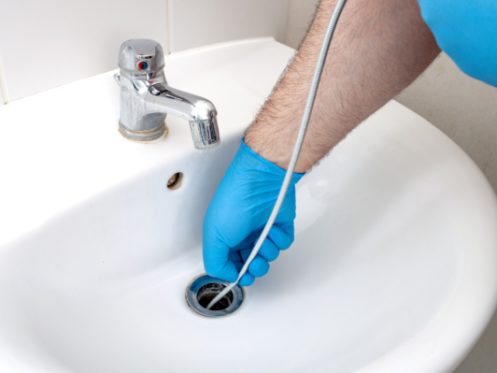Often, plumbing emergencies can arise at the least expected times and lead to disruptions in daily life. Fortunately, some plumbing issues are relatively simple repairs and may be tackled without professional assistance. With the right knowledge and some basic tools, it is possible for anyone, even those without expertise in this area, to tackle simple tasks like unclogging a drain. Below are some tips and tricks on handling these common problems yourself.
1. Know Where the Main Valves Are Located
The main valve of your house is responsible for controlling the water supply. Knowing this main valve’s location is essential in an emergency, as it will quickly shut off the water supply and prevent flooding and significant damage.
The main valves are usually near the water meter outside your home. In addition, it’s handy to know where the shutoff valves are located for your toilet and appliances like your dishwasher or washing machine. This lets you turn off a particular appliance or area instead of the entire water supply. Knowing where these valves are can give you time to assess the extent of a water leak and decide the best course of action.
2. Always Have the Necessary Tools
The right tools can make a huge difference in DIY plumbing. You should have two plungers: a sink plunger and a flange plunger. A sink plunger works well for sink and shower clogs, while a flange plunger has a cup designed to fit a toilet drain to create more suction.
Having a dedicated plunger for your toilet is beneficial because they work much better than general-purpose ones. Having a separate plunger for your sinks and showers avoids cross-contamination of sewage. In addition, a few basic items, such as a pipe wrench, adjustable wrenches, and screwdrivers, will be handy for most minor repairs.
3. Regular Inspections
When it comes to plumbing, inspections can prevent a problem before it becomes a major issue. Inspect faucets for leaks or damage and use a flashlight to get a better look at pipes under sinks in the bathroom room and kitchen. You can use a pipe wrench to tighten larger nuts, like the one below the sink. Placing a cloth between the teeth of the wrench and the nut should prevent scratching. Additionally, checking for cracks, corrosion, or other signs of wear and tear is key to preventing plumbing issues in the future.
You should also check the hoses and pipes running to toilets, dishwashers, and washing machines for leaks or loose hardware. You can use an adjustable wrench to tighten up loose nuts. In addition, you can tighten the screws on the brackets holding pipes to the wall next to appliances with a screwdriver. Regular plumbing inspections will help you save money in the long run as it decreases the chance of having major plumbing repairs down the line.
If you spot any cracks or corrosion during your inspection, it’s best to call a professional plumber for help. These issues will probably require replacing pipes. Additionally, unless you have plumbing experience, it is probably better to leave working on fixtures to the pros.
4. Prevent Drain Clogs
Clogs in your bathroom sink or bathtub drain are a common problem. These are usually caused by hair and soap getting lodged in your pipes. If you do not already have them installed, sink and shower strainers can catch most of the debris before it goes down the drain and causes an issue. It is also helpful to lean away from your sink when drying and brushing your hair, as it is easier to sweep the floor than clean out the drain. For gentlemen, place a towel over the sink to catch hair when shaving or trimming your beard.
In the kitchen, clogs often happen due to disposing of fats and oils down the drain. They can solidify and stick to the sides of pipes, preventing water from draining properly. In addition, use a sink strainer to prevent food scraps from going down the drain. To avoid clogs, do not pour anything other than water down your drains. If you have an oil or grease spill in the kitchen, soak it up with paper towels and discard them.
5. Unclogging a Drain
If you already have a clogged drain, try a plunger. You want the plunger to be covered in water so it creates a vacuum seal over the drain. If the water will overflow when you start plunging, use a cup and remove some of the water. If there is not enough, add water until the rubber part of the plunger is submerged. Put the plunger in at a 45-degree angle to retain more air, allowing for more downward pressure.
Next, move the plunger so the handle sticks straight up. Push down with a gentle thrust at least two or three times. Continue this action until the water level in the sink, shower, bathtub, or toilet goes down. Remove the plunger and flush the toilet or run the water to make sure everything is working as it should. If the clog is in a double basin sink in the kitchen, you may have to cover the drain on the unclogged side to create enough pressure for the plunger to work. You can use another plunger or a rag to create a seal. If plunging is unsuccessful, you will probably have to call a professional for drain cleaning.
6. Watch Out for Frozen Pipes
Frozen pipes can be a real hassle. As the water expands, it can crack the pipes. Also, frozen water in a pipe can cause water buildup in your home, leading to flooding and other damage.
Before frigid weather hits, ensure any exposed pipes are properly insulated or heated to prevent freezing. You will also want to take the time to drain outdoor faucets. Pipes leading to outdoor faucets usually have a shutoff valve inside. This valve can either be a handle you can turn to the off position or a nut to tighten to stop the water flow. After the valve has been closed, drain the water in the pipe by turning the outdoor faucet on. If you cannot find the valve or there is not one present, it may be a good idea to call a plumber to have one installed or help you locate the existing one to prevent frozen pipes.
If the pipes under your kitchen or bathroom sinks freeze, try thawing the ice with a hairdryer on low heat. Alternatively, try soaking a towel in hot water and wrapping it around the pipe. If the plumbing is in a cabinet under a sink, open the cabinet doors before extreme weather events to allow heat in and prevent frozen pipes. If your pipes do freeze, it’s best to call a plumber immediately. Frozen pipes can lead to severe property damage if not taken care of promptly and correctly.
Contact the Professionals
At Summit Heating & A/C, we have been serving the residents of Littleton, CO since 1998. We are expert plumbers and electricians, and we also install, repair, and maintain heating and cooling systems. Contact us today if you are experiencing any plumbing, HVAC, or electrical issues.


